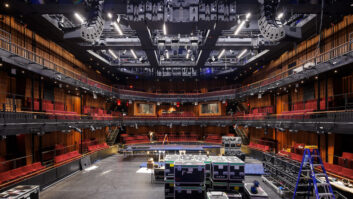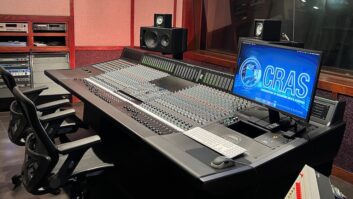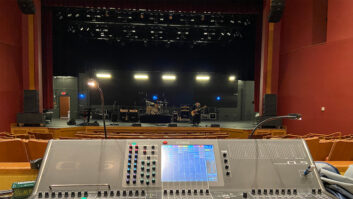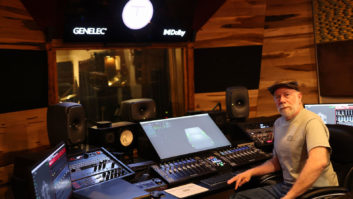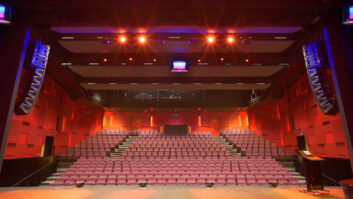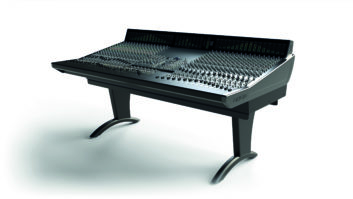Useful Arts first popped onto my radar at an AES convention in Milan, Italy, where Wave Distribution’s Gil Griffith introduced me to Peter Swann, Useful Arts’ designer.
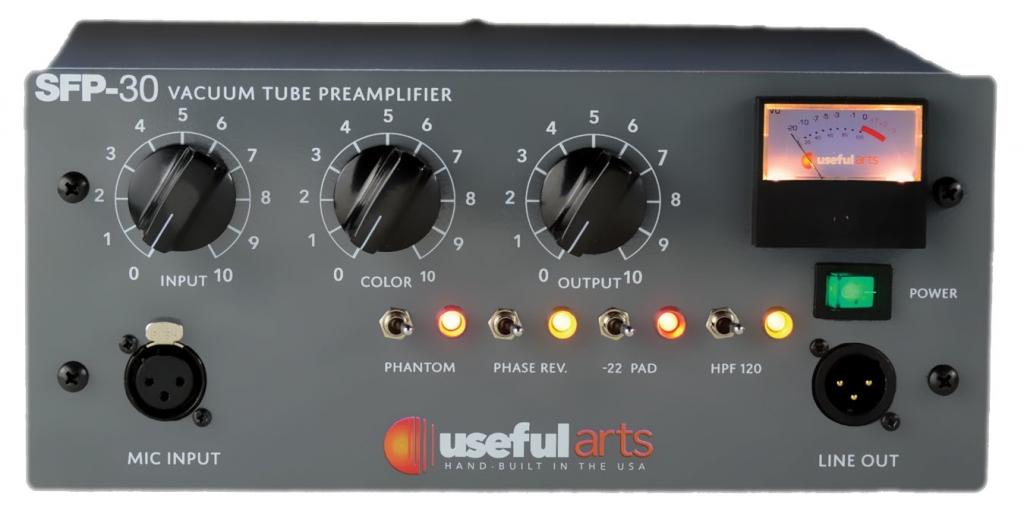
When you build audio gear that reminds me of vintage broadcast equipment and add to that some cool blue meters, you have my interest piqued. My initial hands-on experience was with the SFP-60 stereo unit at a great space in Tuscany called The Garage Studio. We’ll be focusing on the mono unit, the SFP-30, though I’ll also throw in some information on the BF-1 Preamp/DI.
It became instantly obvious that Swann cares a great deal about sound and the signal path. Everything he designs is Class A tube and hand-built in the USA. The Useful Arts philosophy is that they don’t make clones of classic gear, but rather devices inspired by units from the 1940s, ‘50s and ‘60s paired with modern design techniques.
The SFP-30 is vacuum-tube preamp that packs a serious punch. In the user manual it states that “it is designed to make microphone signals pop in a mix.” And trust me, it does just that! Before we find out how this unit performs in the studio, let’s have a quick glance at the controls on the front panel.
The balanced Inputs and Outputs are gold-plated XLRs with pin 2 hot configuration and a nominal 600-Ohm impedance. There’s a green, illuminated, rocker-style power switch. In order for the tubes to warm up, the high-voltage PSU will engage after 15 to 20 seconds.
The gain structure in this unit is not just controlled by the usual “gain” pot. There are three controls—Input, Output and Color—which interact in order to get the right levels and sonic character.
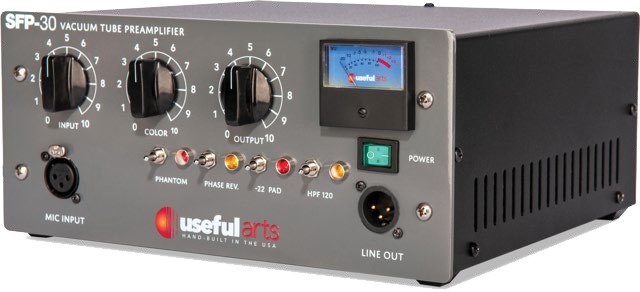
The Input knob controls the level between the first stage, which has the input transformer and EF806 pentode, and the next stage in the chain, containing a triode voltage amp. It’s right here where you can acquire some pretty significant tube saturation.
Output controls the drive of the signal to the output transformer.
The Color control dials in secondharmonic distortion. This will offer you bite and extra detail in the signal. This feature can be extremely helpful when using microphones that are harsh or thinsounding. Adding Color can beef up the signal and reduce some of that harshness.
In addition to the controls, there’s a 6dB/octave highpass at 120 Hz, a 22dB pad, 48V Phantom Power and, of course, the very cool blue VU meter.
So how did this little box of wonder perform in the recording environment? So far I had only heard what the unit could do on my own vocals at trade shows. Now I wanted to try it out on a snare drum; I wanted to hear how it behaved on high and fast transients.
I like to do this thing where I have a Sennheiser 441 and an MKH-40 on the top of the snare. I used the SFP-30 on the MKH-40 channel, a decent amount of input, and once the Color went up both the drummer’s and the producer’s eyebrows went up. It was stunning that an already kicking snare sound was improved instantly by driving this unit a little harder. I subsequently used it on Luke Higgins’ fine acoustic guitar playing and on the singer’s lead vocals.
In all instances, the SFP-30 delivered warm and punchy material that slots perfectly into the mix. In all these applications, the magic number on the Color control seems to sit around the number 6.
This unit can be subtle, too. We got to use it on one of the celli in a string quintet where a subtle amount of Color just brought that cello to life. It started to get annoying that things that sounded great before now sounded even better! And of course, in true analog fashion, you can go over the top without it sounding bad. If it sounds good for the job, it’s right. Moving on…
I needed to record a vocal for a punk track I was going to mix. Everything else had been recorded already, but the client wanted me to produce and record the final vocals. So I spent a fun day at The Park Studios in London tracking lead and backing vocals. It was a pretty angry tune, and it really wanted some kick-ass, mean vocals. Usually I’d rely on some distortion tricks when it comes to mixing, but since I new the canvas for the mix, I was in a position to make these decisions during the recording process.
The client had a little bit of red light fever, so he booked the entire day, which gave me some time to do a few microphone/preamp shootouts. The winning pair was the Advanced Audio CM251 and the Useful Arts SFP-30. The mic gave me an open and detailed vocal to feed into the preamp. Driving both the Input and the Color controls resulted in a solid, punchy and pretty aggressive vocal that slotted into the mix perfectly.
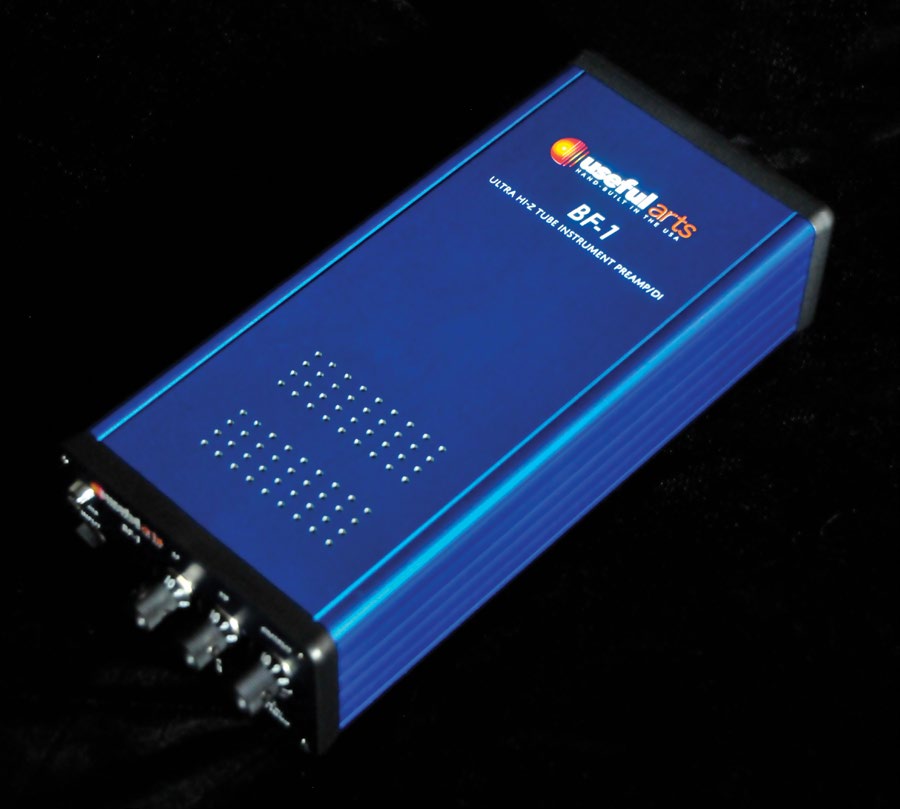
The SFP-30 packs the original SFP-60 dual-channel unit’s design in a sturdily, hand-built desktop unit. The three-way interactive input/output control design makes this an extremely versatile microphone preamp that can go from transparent to subtle to a full on tube powerhouse.
If there’s one drawback someone might flag, it’s the lack of a DI/Instrument input. But fear not, BF-1 to the rescue.
The BF-1 is not just a DI. This box was designed with guitarists and bass players in mind, with the remit to make sure all the dynamics and delicate nuances are translated to amp, console or DAW.
As Swann explains, “It all boils down to impedance. DAWs and consoles generally have an input impedance of about 10-100kΩ which is far too low for a guitar or bass pickup.” Swann and Useful Arts approached this design by making the pickup do less of the hard work, and they achieved this by making the BF-1 have 20 million Ohm input impedance!
As it turns out, the perfect tool for this job is a vacuum tube. So that begs the question: “I already have a tube amp, why do I need a tube DI?” Well, they do different things. The tubes in amps deal with high gain stages, which lowers the input impedance. The tube stage in the BF-1 works in a similar way to a tube microphone. Here, the tube converts impedances without high gain.
In addition to the stunningly high impedance conversion, the BF-1 also offers a Class A tube preamp, a nifty two-band EQ and multiple outputs.
As on the preamps, the connectors are gold-plated. As with other DIs the Input jack accepts the input from the instrument. The Thru jack gives a carbon copy of the unprocessed input signal. On the back of the unit are a balanced XLR to feed your favorite preamp and an extra jack to feed the amp.
The red pushbutton on the front panel selects between Lo and High gain. High gain allows you to run the unit with a line level output. If you’re going to link on through to an amp, the Lo setting should be used. The Lo setting also allows you to engage the EQ. This is not your regular console-style EQ. It has been designed to be bass/guitar-friendly. The LF control will provide a gentle bass boost from 1 to about 8. From 9 to 10 it will boost those frequencies dramatically. The same character goes for the HF, which is set around 700 Hz.
I got to use the BF-1 in various situations, the most memorable being a recording for the National Theatre in London. The music is a 10-minute oeuvre that goes from reggae to soca, then into grime, spoken word and calypso. Everything was being recorded live, and I decided to track the bass through the BF-1.
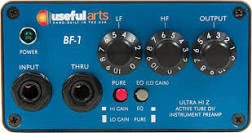
The unit was being blasted with not just various styles but with a whole array of bass pedals. My usual B-15/Fet47 bass setup did a great job. When I blended in the Useful Arts channel, things changed dramatically. The BF-1 delivered so much detail, warmth and control that it instantly became the main bass channel with some extra amp support.
Useful Arts has created some outstanding tools for a digital world with a constant desire for analog warmth. Get your hands on these units, plug in and be amazed.
PRODUCT SUMMARY
COMPANY: Useful Arts
PRODUCTS: SFP-30 Microphone Preamp & BF-1 Instrument DI
WEBSITE: www.usefulartsaudio.com
PRICE: SFP-30: $1299. BF-1: $799
PROS: Sturdy build; sonically versatile
CONS: SFP-30: no instrument input
